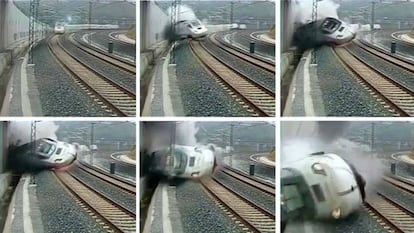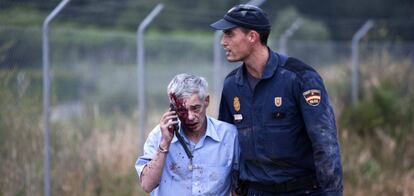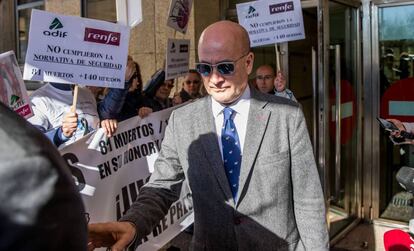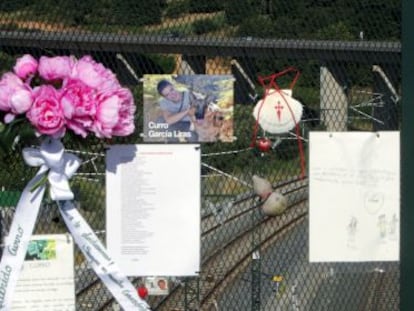Five years on, Galicia train crash shines spotlight on security of Spain’s rail network
The EU has pushed Spain into improving its investigation of the accident that killed 80 people near Santiago de Compostela on July 24, 2013


It was a 16-page report completed on January 16, 2016 by a railroad expert named Christopher Carr in the French city of Valenciennes that began debunking the Spanish government’s story about the train crash of July 24, 2013 that killed 80 people near Santiago de Compostela in Spain’s deadliest railway accident.
The only hope of clearing up this case lies in Europe. The congressional investigative committee is just for show
MEP Ana Miranda
Carr, who was head of the security department at the European Union Agency for Railways (ERADIS), which answers to the European Commission, said in his report that the investigation conducted by Spain’s Public Works Ministry had violated EU regulations because Renfe and Adif – the railway operator and infrastructure manager – had essentially investigated themselves. And these state-owned companies were clinging to the theory of human error by the train driver, ignoring the deeper causes of the tragedy, chiefly, the decisions made earlier by company officials minimizing the dangers to passengers of the sharp curve at Angrois.
Five years after the derailment at that precise spot, the EU has forced Spain to overhaul the way railway accidents are investigated. It has also put a spotlight on the entire risk analysis system of the Spanish railway system. What EU technicians concluded in their report was the same thing that survivors of the accident had already told Public Works Minister Ana Pastor just two months after the crash. “She defended the independence of the Railway Accident Investigation Committee (CIAF), saying she did not know them personally and that they were good professionals,” recalls Jesús Domínguez, the spokesman for the victim support group Plataforma Víctimas Alvia 04155.
Yet the CIAF team included the two directors of safety at Renfe and Adif, and it had the backing of a consulting firm named Ineco, which Renfe and Adif are both stakeholders in. Officials and technicians from all three bodies are now under investigation for failing to have properly assessed the risk of the Angrois curve, where the European Rail Traffic Management System (ERTMS), which automatically brakes trains exceeding designated speeds, had been deactivated. This system would have stopped the train when the driver failed to do so due to a distraction.

The EU agency issued its report in 2016 after victims resorted to it in despair, having been stonewalled repeatedly in Spain. They sought advice from a support group for victims of the Valencia metro accident of 2006 and from Ana Miranda, a member of the Galician regional party BNG who has a seat in the European Parliament. These sources recommended filing complaints before European authorities, and in November 2015, victims’ representatives traveled to Brussels and “met for two and a half hours with the EU’s top officials on railway security,” says the MEP Miranda. “That was a milestone. EU officials were surprised at the victims’ technical knowledge. ”
The tide had turned. ERADIS officials pledged to draft a report on the Spanish train crash. The study was completed in January 2016, but it was not released to the public until July, after the June general elections in Spain. “It took six months because legally they could not make it public until then, since there were sanction proceedings against Spain for the lack of independence of its investigative committee, but also there was state pressure at the highest level,” said Miranda.
During those six months that the report remained under wraps, the judicial investigation into the crash took a surprising turn back in Spain. The provincial court of A Coruña, which had refused to charge public officials targeted by the original investigating judge, suddenly changed tack. Until then, the train driver, Francisco José Garzón, had been the only individual facing charges in the case. But now the court decided to dig deeper. The victims suspect that it was aware of the EU document that was about to be published. “If the court had closed the case with the driver as the sole person facing charges, it would have looked ridiculous.” says Domínguez.

The EU railway agency stepped in a second time at the victims’ request, helping make some sense out of the controversial decisions made by Adif and Renfe between 2011, when the high-speed line between Ourense and Santiago became operative, and the night when the train driver was distracted by an internal phone call from the conductor and failed to slow the train down from 200 kilometers per hour to 80 km/h ahead of the sharp bend. A new report that reached the judge in June found that both companies should have conducted mandatory risk analysis at that spot, particularly after they decided to disconnect the ERTMS automatic braking system.
“The only hope of clearing up this case lies in Europe. The Congress’ investigative committee is just for show,” says Miranda. The victims underscore that the accident “has upended the way things work in railway management.” This includes charges against Andrés Cortabitarte and Antonio Lanchares, the chief officials overseeing security at Adif and Renfe in recent years. And a new ERADIS report exploring the way that Adif and Renfe work to meet safety requirements is about to see the light. This audit was requested by the European Commission.
English version by Susana Urra.
Tu suscripción se está usando en otro dispositivo
¿Quieres añadir otro usuario a tu suscripción?
Si continúas leyendo en este dispositivo, no se podrá leer en el otro.
FlechaTu suscripción se está usando en otro dispositivo y solo puedes acceder a EL PAÍS desde un dispositivo a la vez.
Si quieres compartir tu cuenta, cambia tu suscripción a la modalidad Premium, así podrás añadir otro usuario. Cada uno accederá con su propia cuenta de email, lo que os permitirá personalizar vuestra experiencia en EL PAÍS.
¿Tienes una suscripción de empresa? Accede aquí para contratar más cuentas.
En el caso de no saber quién está usando tu cuenta, te recomendamos cambiar tu contraseña aquí.
Si decides continuar compartiendo tu cuenta, este mensaje se mostrará en tu dispositivo y en el de la otra persona que está usando tu cuenta de forma indefinida, afectando a tu experiencia de lectura. Puedes consultar aquí los términos y condiciones de la suscripción digital.
More information
Archived In
Últimas noticias
Half of Scotland is in the hands of 420 property owners
How Japan is trying to avert ‘digital defeat’
The complicated life of Francesca Albanese: A rising figure in Italy but barred from every bank by Trump’s sanctions
From digital curfews to blocking apps: How technology experts protect their children online
Most viewed
- Pablo Escobar’s hippos: A serious environmental problem, 40 years on
- Why we lost the habit of sleeping in two segments and how that changed our sense of time
- Trump’s obsession with putting his name on everything is unprecedented in the United States
- Charles Dubouloz, mountaineering star, retires at 36 with a farewell tour inspired by Walter Bonatti
- The Florida Keys tourist paradise is besieged by immigration agents: ‘We’ve never seen anything like this’










































